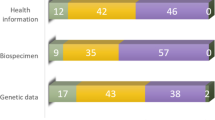Abstract
Switzerland has an excellent culture of medical research and is a melting pot for medical experts with international expertise. Nevertheless, as in other countries, the resources available to medical researchers are not being fully used. Biological samples, which enable a host of medical research studies to be carried out without invasive methods involving patients, are frequently left unused or forgotten. The aim of this study is to examine the experiences of biobank stakeholders regarding the use or underuse of biosamples, in order to develop paths to optimize biosample research. Interviews were carried out with 36 biobank stakeholders in Switzerland concerning their experiences with biosample use, and the possible obstacles at each stage of the process. Interviews revealed that standard operating procedures were the most frequently cited obstacle, although these were not judged to be severe hindrances. Despite a stated desire to develop biosample research, skepticism of sharing networks and wariness of new partnerships were strong themes. Biobanking still functions as an emerging field, in which exchange practices have yet to be established at the national and international levels. Sample exchange continues to function largely based on personal contacts; while this is an inherent feature of competitive medical research, opportunities for large-scale studies may be lost due to excessive caution.
Similar content being viewed by others
References
Asslaber, M., & Zatloukal, K. (2007). Biobanks: Transnational, European and global networks. Briefings in Functional Genomics & Proteomics, 6(3), 193–201. doi:10.1093/bfgp/elm023.
Betsou, F., Rimm, D. L., Watson, P. H., Womack, C., Hubel, A., Coleman, R. A., Horn, L., Terry, S. F., Zeps, N., Clark, B. J., Miranda, L. B., Hewitt, R. & Elliott, G. D. (2010). What are the biggest challenges and opportunities for biorepositories in the next three to five years? Biopreservation and Biobanking. doi:10.1089/bio.2010.8210.
Colledge, F., & Elger, B. (2015). Getting a fair share: Attitudes and perceptions of biobank stakeholders concerning the fairness of sample sharing. Bioethics, 29(6), 424–430. doi:10.1111/bioe.12134.
Colledge, F., Elger, B., & Howard, H. C. (2013a). A review of the barriers to sharing in biobanking biopreservation and biobanking, 11(6), 339–346. doi:10.1089/bio.2013.0039.
Colledge, F. M., Elger, B. S., & Shaw, D. M. (2013b). “Conferring authorship”: Biobank stakeholders’ experiences with publication credit in collaborative research. PLoS ONE, 8(9), e76686. doi:10.1371/journal.pone.0076686.
Colledge, F., Persson, K., Elger, B., & Shaw, D. (2014). Sample and data sharing barriers in biobanking: Consent, committees, and compromises. Annals of Diagnostic Pathology, 18(2), 78–81. doi:10.1016/j.anndiagpath.2013.12.002.
Dillner, J., & Andersson, K. (2011). Biobanks collected for routine healthcare purposes: Build-up and use for epidemiologic research. Methods in Molecular Biology, 675, 113–125. doi:10.1007/978-1-59745-423-0_4.
Gibbons, S. M. C. (2009). Regulating biobanks: A twelve-point typological tool. Medical Law Review, 17(3), 313–346. doi:10.1093/medlaw/fwp016.
Hagen, H. E., & Carlstedt-Duke, J. (2004). Building global networks for human diseases: Genes and populations. Nature Medicine, 10(7), 665–667. doi:10.1038/nm0704-665.
Harris, J. R., Burton, P., Knoppers, B. M., Lindpaintner, K., Bledsoe, M., Brookes, A. J., Budin-Ljosne, I., Chisholm, R., Cox, D., Deschênes, M., Fortier, I., Hainaut, P., Hewitt, R., Kaye, J., Litton, J. E., Metspalu, A., Ollier, B., Palmer, L. J., Palotie, A., Pasterk, M., Perola, M., Riegman, P. H. J., van Ommen, G. J., Yuille, M. & Zatloukal, K. (2012). Toward a roadmap in global biobanking for health. European Journal of Human Genetics, 20(11), 1105–1111. doi:10.1038/ejhg.2012.96.
Kiehntopf, M., & Krawczak, M. (2011). Biobanking and international interoperability: Samples. Human Genetics. doi:10.1007/s00439-011-1068-8.
Mehrjahresprogramm 2012–2016. Planungseingabe zuhanden der Bundesbehörden. (2010). Bern: Stämpfli Publikationen AG.
Meier-Abt, P. (2013). Die schweiz braucht mehr biobank. Digma, 13(3), 81–83.
Rogers, J., Carolin, T., Vaught, J., & Compton, C. (2011). Biobankonomics: A taxonomy for evaluating the economic benefits of standardized centralized human biobanking for translational research. JNCI Monographs, 2011(42), 32–38. doi:10.1093/jncimonographs/lgr010.
Rothmayr, C. (2009). Biobanks: Governance in comparative perspective—edited by Herbert Gottweis and Alan Petersen. Governance, 22(4), 759–761. doi:10.1111/j.1468-0491.2009.01461_6.x.
Shaw, D. M., Elger, B. S., & Colledge, F. (2014). What is a biobank? Differing definitions among biobank stakeholders. Clinical Genetics, 85(3), 223–227. doi:10.1111/cge.12268.
Vaught, J., Kelly, A., & Hewitt, R. (2009). A review of international biobanks and networks: Success factors and key benchmarks. Biopreservation and Biobanking, 7(3), 143–150. doi:10.1089/bio.2010.0003.
Vaught, J., Rogers, J., Carolin, T., & Compton, C. (2011). Biobankonomics: Developing a sustainable business model approach for the formation of a human tissue biobank. JNCI Monographs, 2011(42), 24–31. doi:10.1093/jncimonographs/lgr009.
Acknowledgements
The authors would like to acknowledge the contribution of Heidi Howard, who developed the interview guide, supervised the data collection, and assisted with the coding; David Shaw, who assisted in developing codes and data analysis; and Kirsten Persson, who also give input into coding and evolution of the project. Flora Colledge’s doctoral research was funded in part by the Käthe-Zingg-Schwichtenberg Fonds of the Swiss Academy of Medical Science.
Author information
Authors and Affiliations
Corresponding authors
Ethics declarations
Conflict of interest
None.
Rights and permissions
About this article
Cite this article
Colledge, F., Passweg, J. & Elger, B. Obstacles to Widening Biosample Research. Sci Eng Ethics 25, 113–128 (2019). https://doi.org/10.1007/s11948-017-9985-0
Received:
Accepted:
Published:
Issue Date:
DOI: https://doi.org/10.1007/s11948-017-9985-0




